TennisOne Lessons
![]()
The Essentials of Shot Making: Movement
Feisal Hassan, USPTA Master Professional
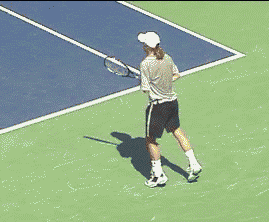 Tennis is a game of movement and those who move best tend to do best. |
Tennis is a game of movement and should be trained as such. It's a game of continuous emergencies. Every shot can have a different speed, spin and placement.
The way a player moves on the court determines how successful he/she can be as a tennis player. Tennis performance depends upon quick bursts of speed interspersed with variations of fast lateral and side-to-side movements.
There are several factors that affect movement in tennis:
Statistics have shown that 70% of missed or poorly hit shots are due to poor footwork. In tennis, it's not necessarily how fast you are, it's how fast you are relative to the ball .
Some of the required movement skills that can be enhanced through training are:
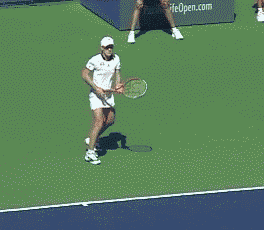 Split step, crossover, accelerate, decelerate, split step, crossover, shuffle - tennis is a game of constantly changing footwork patterns. |
Improving Foot speed
In order to improve foot speed, a player needs to train the following components: starting ability, acceleration, stride rate and stride length. These components apply to all sports. A sprinter in track and field is commonly known to accelerate for the first 60 feet of his or her run. Since a tennis court is 39 feet from the baseline to the net, one can conclude that all running in tennis includes constant acceleration, until the deceleration needed to get in position to hit the ball. Therefore, the emphasis on improving foot speed in tennis should be on efficient and quick starts, acceleration, and efficient deceleration.
In tennis, every point starts from a stationary position. For example, return of serve, volleys, and doubles play at the net . Thus, a player's starting ability is crucial.
Agility
This is a player's ability to change directions with the least amount of speed loss. In tennis, research has concluded that a player changes direction on average of 4-5 times per point.
Studies show that tennis movement in tennis involves:
Movement experts suggest that agility training should be as follows:
Changing Footwork Patterns
If you watch the footwork of tennis players closely, you will see a variety of footwork patterns occurring during a single shot and note that tennis requires the player to change from one footwork pattern to another rapidly and efficiently!
For example, a player may run to the ball, decelerate, and then side shuffle back for recovery. A player may also transition from shuffling to running or from crossover step to a run. These “changing footwork patterns” must be trained and coordinated so that players can efficiently and effectively transition from one footwork pattern to another.
Speed Endurance
On average, studies indicate that 300-500 bursts of energy are required during a singles match. Speed is important for each of these bursts of energy but players must also be able to sustain this energy during the entire match, especially the final set.
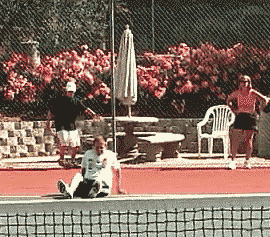 Drill: Tag Sprints |
The goal of this article is to demonstrate a simple on-court Tennis Specific Movement Training program that will improve the performance of a tennis player. I have had success categorizing drills into a program. Numerous drills that I will share in this article have been acquired from various coaches and players throughout my coaching career.
The Movement Training Program
The movement-training program is broken down into four types and levels of exercises:
Level 1: Improving Foot Speed
Purpose: to train players with speed development.
Drill: Tag SprintsPlayer “A” is sitting down on the baseline facing the net. Player “B” is standing against the back fence. Player "A"s goal is to get up and sprint to the net, without getting tagged by player"B". Player "B" is trying to tag player "A" before s/he touches the net. On the coach's whistle or command of “GO”, Player “B” tries to tag player “A” before s/he touches the net.
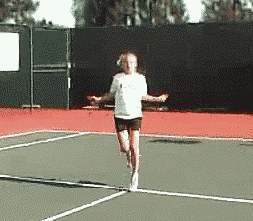 Drill: Jumping Rope - Several jump rope patterns can be used. |
Drill: Push-up and Catch
Player “A” is in a push-up position on the baseline facing the net, player “B” or a coach rolls a ball between Player “As legs, player “A” sprints and catches the ball before it passes the service line.
Drill: Get Ups
Player is sitting (on their butt and hands back) on the baseline, on the command of “GO” the player gets up and sprints to the net.
Level 2: Agility
Purpose: To train players to change directions with the least amount of speed loss.
Drill: Jumping Rope
This is good for agility, balance, timing, coordination and quick reactions.
Generally, record the number of jumps in 30 seconds, rest for 30 seconds.
Several jump rope patterns can be used: double foot hop, right foot hop, left foot hop, heel kicks, high knees or a forward and side hop are some of the jump rope patterns I utilize.
Drill: Balance Volleys
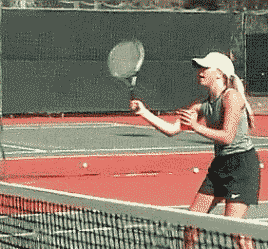 Balance Volleys |
A player keeps a cup of water in their non-dominant hand and volleys back and forth with another player. The goal being to change directions to hit the volleys without spilling water from the cup.
Drill: Push and Hop
Three players form a triangle; the fourth player (who is in the middle of the three players) hops on one leg and is gently pushed by the three in the triangle.
Drill: Circle Run
The coach rolls a ball toward the net; the player (who is standing on the baseline) moves toward the net and is trying to circle around the rolling ball. Count the number of times the player went around the ball before the ball touched the net.
Level 3: Changing Footwork Patterns
Purpose: To train a player to change from one footwork pattern to another rapidly.
DRILL:
Player starts standing on the baseline, coach will call four types of footwork patterns to be performed. The player is instructed to change the footwork patterns each time they cross the service line and when they touch the net. If “sprint”, shuffle, backwards, sprint” are called out, for example, the player sprints to the service line. Without stopping, the player transitions from a sprint to a shuffle as rapidly as possible. At the net, he immediately backpedals to the service line. At the service line, he would rapidly transition to a sprint.
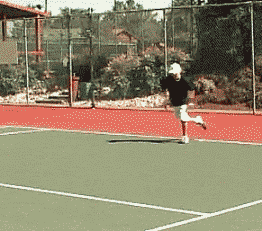 Changing Footwork Patterns |
A variety of footwork patterns can be used, including a crossover step, a carioca step and a single leg and double leg bounding and hopping. Remember, the most common footwork patterns in tennis are shuffle and run. According to Scott Phelps, former top 10-world class sprinter, the maximum length of time running in a straight line for tennis should be 8-12 seconds.
I also suggest that players must carry a tennis racquet and simulate strokes when doing this drill.
Some common patterns used are:
Level 4: Speed Endurance
Purpose: To train a player to repeatedly perform maximum or near maximum bursts of energy required for an entire match.
Drill: Pick Up Sprint
Jog, Stride, Sprint, Walk.
Jog for the length of the court, then Stride for the width of the court, then Sprint for the length of the court, and then Walk for the width of the court. Repeat for 10 sets.
Drill: Wind Sprints
Jog for length of court and then sprint for the width of court. Repeat for 10 sets.
Implementing the Program
Rather than work on one level at a time, I suggest it is more effective to work on three or four levels in each session. In this way, you will simulate the way movement is used in tennis. For example, a player doesn't rely on agility alone; movement requires changing footwork patterns and speed endurance as well. Thus, it makes good sense to train skills together in an integrated program. A tennis player then can call upon them all spontaneously during a match.
I hope this article serves as an example on how tennis movement and footwork can be trained. The drills presented are just some on-court examples and should only serve as guidelines. I have had success with this program.
The next article will be on balance training.
See Feisal Hassan's previous article: The Essentials of Shot Making: Vision in the TennisOne Lesson Library.
Your comments are welcome. Let us know what you think about Feisal Hassan 's article by emailing us here at TennisONE
![]()
 Feisal Hassan, a USPTA Master Professional and PTR certified professional, is a member of the Head/Penn Racquet Sports National Advisory Board and National Speaker's Bureau, the Director of Certification & Testing for the USPTA Middle States division and a USA High Performance Coach.
Feisal Hassan, a USPTA Master Professional and PTR certified professional, is a member of the Head/Penn Racquet Sports National Advisory Board and National Speaker's Bureau, the Director of Certification & Testing for the USPTA Middle States division and a USA High Performance Coach.
Feisal was the Director of Coaches' Education and Junior Davis Cup Team Coach for Tennis Zimbabwe.
Feisal was also voted in Tennis Industry magazine's prestigious “40 Under 40” list for being one of the top 40 men and women under 40 years old who have had and will continue to have a strong influence in the sport and in the business of tennis- both nationally and internationally.
Feisal is currently the Director of Tennis at the Regency Sport and Health in McLean, Virginia.